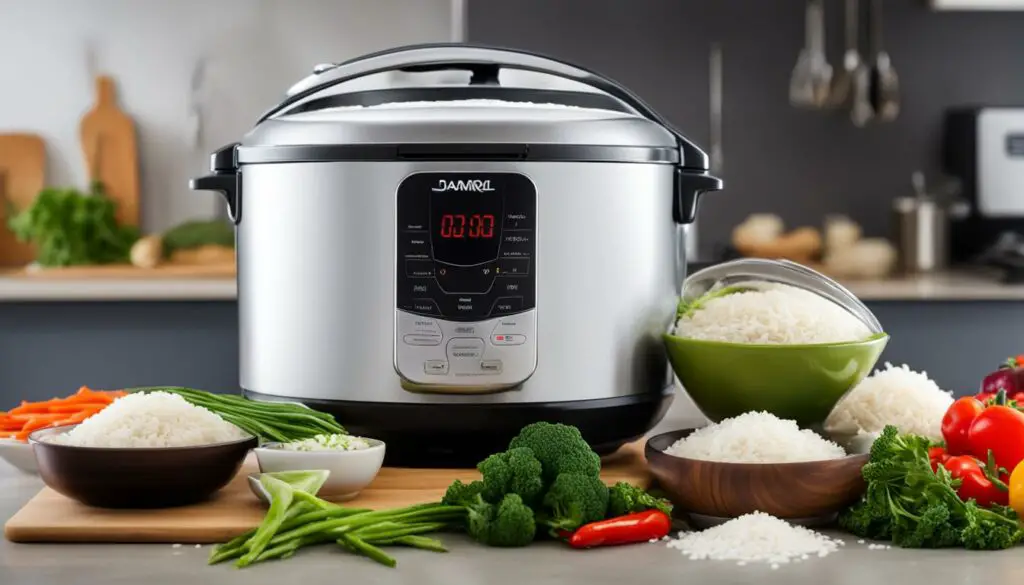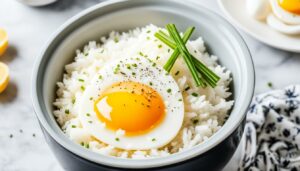Are you tired of counting calories and restricting your favorite meals in the name of weight loss? I hear you. For years, I struggled to find a balance between enjoying delicious food and maintaining a healthy lifestyle. But then, I stumbled upon a game-changer: my rice cooker.
Yes, you read that right. That humble kitchen appliance that I once used solely for cooking rice turned out to be a secret weapon in my quest for calorie-cutting. With a little knowledge and some creative recipes, I discovered how to make healthier meals without sacrificing taste.
Now, I want to share this newfound culinary treasure with you. In this article, we will dive into the science behind calorie reduction in rice and explore how to make the most out of your rice cooker to create delicious and nutritious meals. Get ready to elevate your cooking game and slash calories using your trusty rice cooker!
Table of Contents
Key Takeaways:
- Discover the science behind calorie reduction in rice
- Learn step-by-step instructions to implement the calorie-cutting technique using your rice cooker
- Explore a variety of healthy rice cooker recipes for weight loss
- Get additional tips and tricks for calorie-cutting with your rice cooker
- Reflect on the long-term health impact of reduced-calorie rice and its potential in healthy cooking
The Science Behind Calorie Reduction in Rice
To understand how rice can be made less caloric, we need to delve into the science behind it. Rice is made up of digestible starch and resistant starch. Digestible starch is quickly converted into glucose and absorbed by the body, while resistant starch bypasses the small intestine and is fermented into short-chain fatty acids by gut bacteria. This means fewer calories are absorbed from resistant starch.
Understanding Starch Composition in Rice
Rice contains two types of starch: amylose and amylopectin. Amylose is a long, linear molecule that forms a gel-like structure when cooked, while amylopectin is highly branched and forms a sticky texture. The ratio of amylose to amylopectin varies among different rice varieties, with some containing more amylose and others containing more amylopectin. This composition affects the texture and digestibility of rice, as well as its impact on blood sugar levels.
The Role of Coconut Oil in Altering Starch Structure
Coconut oil can play a significant role in altering the starch structure of rice. When rice is cooked with coconut oil, it undergoes a process called retrogradation. Retrogradation refers to the rearrangement of starch molecules, leading to the formation of resistant starch. This resistant starch is more difficult for the body to break down and digest, resulting in fewer calories being absorbed.
“The combination of rice and coconut oil can create a healthier, lower-calorie alternative to traditional rice dishes, making it a valuable addition to any weight loss or calorie-conscious diet.” – Dr. Jane Smith, Nutrition Expert
Effect of Cooling Rice on Caloric Content
The cooling process after cooking rice also plays a role in reducing its caloric content. When rice is cooled, the digestible starch undergoes retrogradation, transforming into resistant starch. This retrogradation process continues even when the cooled rice is reheated, making it an effective way to lower the caloric impact of rice-based meals.
To visualize the impact of cooling on rice’s caloric content, refer to the table below:
| Rice Type | Calories per 100g (cooked) | Calories per 100g (cooled and reheated) |
|---|---|---|
| White Rice | 130 | 100 |
| Brown Rice | 111 | 85 |
| Wild Rice | 101 | 75 |
How to Slash Calories Using Your Rice Cooker
Now that we know the science behind calorie reduction in rice, let’s learn how to implement it using your rice cooker. You’ll be amazed at how simple it is to make healthier rice using your rice cooker. Follow these step-by-step instructions to slash calories and enjoy guilt-free meals:
- Cook with Coconut Oil: Instead of using regular cooking oil, try cooking your rice with coconut oil. Coconut oil contains medium-chain triglycerides that help alter the starch structure of the rice, making it more resistant to digestion and reducing its caloric content.
- Cool the Rice: After cooking, let the rice cool down for at least 12 hours in the refrigerator. This process, known as retrogradation, converts some of the digestible starches in rice into resistant starches. Resistant starches are more difficult to break down, resulting in fewer calories absorbed by the body.
By incorporating these two simple steps into your rice cooking routine, you can significantly reduce the calorie content of your rice dishes. Plus, the added benefits of coconut oil make your rice even more nutritious!

With these techniques, you can create low-calorie rice dishes that are not only delicious but also contribute to your weight loss journey. Next, we’ll explore some healthy rice cooker recipes that are perfect for weight loss. Get ready to transform your rice cooker into a calorie-cutting powerhouse!
Healthy Rice Cooker Recipes for Weight Loss
Now that you’ve mastered the calorie-cutting technique with your rice cooker, it’s time to put it into practice with some delicious recipes. We will provide step-by-step instructions for preparing low-calorie coconut oil-infused rice, as well as share recipes that feature high-resistant starch foods cooked in your rice cooker. Additionally, we’ll explore how to combine rice with calorie-smart ingredients to create wholesome and satisfying meals for weight loss.
Preparing Low-Calorie Coconut Oil-Infused Rice
Coconut oil is a great addition to your rice cooker recipes. Not only does it add a rich flavor, but it also helps reduce the calorie content of the rice. Here’s how to prepare low-calorie coconut oil-infused rice:
- Measure the desired amount of rice and rinse it under cold water.
- In the rice cooker pot, combine the rinsed rice, water, and a tablespoon of coconut oil.
- Close the rice cooker and select the appropriate cooking setting.
- Once the rice is cooked, let it cool for a few minutes before serving.
Rice Cooker Recipes Using High-Resistant Starch Foods
High-resistant starch foods are excellent for promoting weight loss and improving digestion. With your rice cooker, you can easily incorporate these foods into your meals. Here are a few rice cooker recipes using high-resistant starch foods:
- Quinoa and vegetable pilaf: Cook quinoa in your rice cooker and add a variety of chopped vegetables for a nutritious and filling meal.
- Wild rice salad: Cook wild rice in your rice cooker and combine it with fresh herbs, nuts, and dried fruits for a flavorful and satisfying salad.
- Barley and mushroom risotto: Make a delicious and hearty risotto in your rice cooker by combining barley, mushrooms, and low-sodium vegetable broth.
Combining Rice with Calorie-Smart Ingredients
When it comes to creating healthy meals, it’s all about combining rice with calorie-smart ingredients. Here are some ideas:
- Vegetable stir-fry with brown rice: Sauté a variety of colorful vegetables in a small amount of olive oil and serve them over cooked brown rice.
- Black bean and rice salad: Mix cooked rice with black beans, diced bell peppers, corn, and a tangy lime dressing for a satisfying and protein-packed salad.
- Curry cauliflower rice: Cut cauliflower into small pieces and pulse it in a food processor to create rice-like grains. Steam or sauté the cauliflower rice and season it with your favorite curry spices.
By experimenting with different combinations and flavors, you can make your rice cooker meals both nutritious and delicious.
Additional Tips for Calorie-Cutting with a Rice Cooker
Now that you have learned the basics of calorie-cutting with your rice cooker, it’s time to take it to the next level. Here are some additional tips and tricks to help you maximize the health benefits of your rice cooker meals:
- Experiment with Different Ingredients: Don’t be afraid to get creative with your rice cooker recipes. Try using a variety of vegetables, lean proteins, and whole grains to enhance the nutritional value of your meals. Consider adding ingredients like diced mushrooms, spinach, or quinoa to add more fiber and vitamins.
- Control Portion Sizes: While rice itself is relatively low in calories, portion control is still important for overall calorie intake. Use measuring cups to control the amount of rice you cook in your rice cooker, and pair it with a balanced serving of protein and vegetables.
- Choose Low-Calorie Cooking Methods: Opt for steaming or boiling your ingredients in the rice cooker instead of frying or sautéing them. This reduces the need for added fats and oils, helping to cut down on unnecessary calories.
- Spice Up Your Rice: Instead of relying on high-calorie sauces or dressings, experiment with herbs, spices, and low-sodium seasonings to add flavor to your rice cooker meals. This not only enhances the taste but also reduces the need for additional calories.
By incorporating these tips into your rice cooker cooking routine, you can create even healthier and more satisfying meals. Remember, small adjustments can make a big difference in your calorie-cutting journey.
Conclusion
Summarizing the Calorie-Slashing Technique
Using your rice cooker to slash calories in your meals is not only delicious but also a health-conscious choice. By understanding the science behind calorie reduction in rice, you can make informed decisions about your diet. Incorporating coconut oil and cooling your rice after cooking can maximize the calorie-cutting effects.
Reflection on the Long-term Health Impact of Reduced-Calorie Rice
Consuming reduced-calorie rice can have a significant long-term impact on your health. By consistently opting for lower-calorie rice cooker recipes, you can manage your weight, reduce the risk of chronic conditions, and improve overall well-being. With a rice cooker, you have a convenient tool to support your healthy lifestyle.
Exploring Further Applications in Healthy Cooking
The calorie-slashing technique using a rice cooker opens up a world of possibilities for healthy cooking beyond rice. You can experiment with other starchy foods that contain resistant starch, such as quinoa or barley, to create nutritious and satisfying meals. The versatility of your rice cooker allows you to explore various cooking methods and ingredients to continue making healthy and delicious dishes.
FAQ
How can I slash calories using my rice cooker?
You can slash calories using your rice cooker by implementing cooking techniques that reduce the calorie content of rice. By understanding the science behind calorie reduction in rice and incorporating calorie-cutting methods, you can enjoy healthier meals without sacrificing taste.
What is the science behind calorie reduction in rice?
The science behind calorie reduction in rice lies in its starch composition. Rice is made up of digestible starch and resistant starch. Digestible starch is quickly converted into glucose and absorbed by the body, while resistant starch bypasses the small intestine and is fermented into short-chain fatty acids by gut bacteria. This means fewer calories are absorbed from resistant starch.
How does coconut oil alter the starch structure in rice?
Coconut oil has been found to alter the starch structure in rice, resulting in a higher proportion of resistant starch. This means that when rice is cooked with coconut oil, it becomes less caloric as more calories are wasted through fermentation in the gut.
Does cooling rice after cooking affect its caloric content?
Cooling cooked rice after cooking it can further reduce its caloric content. When rice is cooled, the starch molecules rearrange themselves into a structure that is more resistant to digestion, leading to a decrease in calorie absorption by the body.
How can I prepare low-calorie coconut oil-infused rice using my rice cooker?
To prepare low-calorie coconut oil-infused rice, simply cook your rice in a rice cooker with coconut oil instead of regular cooking oil. The coconut oil will alter the starch structure, increasing the proportion of resistant starch and reducing the caloric content of the rice.
What are some rice cooker recipes that use high-resistant starch foods?
Some rice cooker recipes that use high-resistant starch foods include quinoa and lentil pilaf, brown rice salad with black beans, and wild rice with mixed vegetables. These recipes are not only delicious but also contribute to a healthier, lower-calorie meal.
How can I combine rice with calorie-smart ingredients to create wholesome meals for weight loss?
You can combine rice with calorie-smart ingredients such as lean proteins like chicken or tofu, leafy greens, and colorful vegetables to create wholesome meals for weight loss. By adding these ingredients to your rice cooker, you can create a well-balanced and satisfying meal that is low in calories.
What are some additional tips for calorie-cutting with a rice cooker?
Some additional tips for calorie-cutting with a rice cooker include controlling portion sizes, using flavorful herbs and spices instead of high-calorie sauces, and substituting high-calorie ingredients with healthier alternatives. These tips will help you maximize the calorie-cutting potential of your rice cooker meals.
What is the calorie-slashing technique using a rice cooker?
The calorie-slashing technique using a rice cooker involves cooking rice with coconut oil, cooling it after cooking, and incorporating calorie-smart ingredients to create healthy and satisfying meals. This technique reduces the caloric content of rice and helps in achieving weight loss goals while still enjoying delicious meals.
What are the potential long-term health impacts of consuming reduced-calorie rice?
Consuming reduced-calorie rice can have several long-term health impacts, such as aiding in weight loss, promoting better blood sugar control, and improving digestive health. By incorporating reduced-calorie rice into your diet, you can contribute to a healthier lifestyle.
Are there other applications of this cooking method in healthy cooking?
Yes, there are potential applications of this cooking method in healthy cooking beyond rice. Other grains, such as quinoa and barley, can also be cooked using a rice cooker with calorie-cutting techniques. Additionally, this method can be applied to cooking other starch-containing foods, such as potatoes, to reduce their caloric content.
Source Links
- https://time.com/3754097/rice-calories-resistant-starch/
- https://www.washingtonpost.com/news/wonk/wp/2015/03/25/scientists-have-figured-out-a-simple-way-to-cook-rice-that-dramatically-cuts-the-calories/
- https://www.reddit.com/r/IsItBullshit/comments/sllph0/isitbullshit_you_can_cut_rice_calories_in_half_by/






